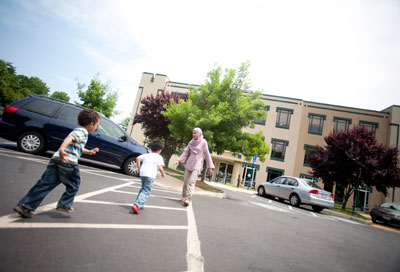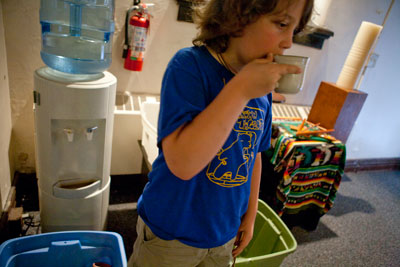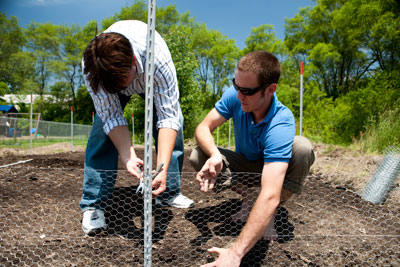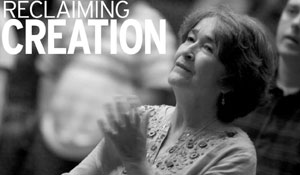Leaders of the secular environmental movement say that the participation of faith communities is critical. At the same time, these partnerships could change the demographic makeup of religious groups and grow membership. To learn more, watch the video introduction below. Then, read the written story that follows.
Evangelical pastor Ken Wilson’s environmental conversion began two years ago with goose bumps, watery eyes and an appeal for help.
“I heard Gus Speth, the dean of forestry at Yale, say to a group of religious leaders, ‘I used to think the top environmental problems facing the world were global warming, environmental degradation and eco-system collapse, and that we scientists could fix those problems with enough science,’” Wilson recalls. “‘But I was wrong. The real problem is not those three items, but greed, selfishness and apathy. And for that we need a spiritual and cultural transformation. And we scientists don’t know how to do that. We need your help.’”
Back home, Wilson thought more about passages in the Bible containing messages of stewardship for the earth. He began preaching about a Christian duty to protect the environment, or “creation care,” at the Vineyard Church of Ann Arbor, Mich., where he is senior pastor.
“It was like I was popping a cork,” Wilson says. “People came up to me in the lobby after the lectures actually with tears in their eyes, saying thank you for speaking to this issue.”
Wilson was surprised to see that many of those people were new to the church.
“There was a Ph.D. in evolutionary biology who came to the church for the very first time for the creation care series, and he said to me, ‘Here’s a church that is finally talking about science in a positive way and actually cares for the environment.’”
Powerful potential

Shahida Shaheen leads preschool children from the playground back into the ADAMS Center in Sterling, Va., June 2, 2009. The mosque has undertaken numerous initiatives to reduce its ecological impact, including campaigns to encourage carpooling and to reduce water use during Wudhu, the washing before prayers. (Photo by Eileen Mignoni)
While only 21 percent of Americans report being active in the environmental movement, a 2008 survey by the Pew Forum on Religion and Public Life found that nearly 90 percent of Americans described themselves as religious.
“Simply based on the numbers, the faith community could be critically important to the environmental dialogue,” says Jerry Lawson, national manager of the Environmental Protection Agency’s Energy Star Small Business and Congregations Network, a division of EPA that helps congregations to reduce greenhouse gas emissions.
Energy Star estimates that if each of the more than 300,000 houses of worship in the United States cut energy consumption by 10 percent, congregations would save $200 million and would eliminate greenhouse gas emissions equivalent to 400,000 cars.
Evangelical support is critical but complex
Because of their large numbers, American evangelicals could be a critical component of the burgeoning eco-religious movement. About 59 million Americans identify as evangelical Protestants, according to the 2008 Pew study.
Evangelical attitudes toward environmentalism are complex. As early as 1970, the National Association of Evangelicals equated preservation of natural resources and ecological balance with preservation of God’s creation.
But around that time, evangelicals began to clash ideologically with scientists and leaders of the early environmental movement over issues of population control and evolution, Wilson says. Environmentalists advocated abortion as a solution to population control, while evangelicals opposed abortion. Meanwhile, political conservatism began to dominate evangelical thought and environmentalists became associated with liberalism.
Executive Pastor Don Bromley of the Vineyard Church of Ann Arbor counts himself a former skeptic of the environmental movement.
“I used to believe stereotypes that environmentalists didn’t care about human beings as much as they did the natural world,” Bromley says. “They were anti-progress.”
Today, those divisions still hold.
The evangelical-oriented Cornwall Alliance for the Stewardship of Creation questions the science of catastrophic climate change. (Mainstream scientists have concluded that the evidence of warming is unequivocal.) The Alliance argues that mandated reductions of greenhouse gas emissions will cause more harm than good because raising energy prices and cutting consumption will retard the economic development of poor regions plagued by disease, premature death and short life expectancies.
Still, signs of conversion are emerging
Tri Robinson, 61, is senior pastor of the Vineyard Boise church. Five years ago, he revisited the Bible when his two adult children questioned the absence of environmental messages in the church. Robinson says he, like Wilson, suddenly saw environmental messages everywhere.
“I realized that issues of the environment were killing the poor and were stimulating things like human trafficking,” Robinson recalls. “I’d tapped a whole new world I’d never seen before.”
Also like Wilson, Robinson preached this message to his congregation. Instead of getting “tarred and feathered,” as he’d feared, he received a standing ovation—his first in 25 years.
“It was like he was filling a gap,” says parishioner Jessie Nilo, who heard Robinson speak that day. “It strengthened my relationship with God, connecting me to his creation in a new way. It’s very freeing to be able to embrace another part of who God is.”
Robinson represents a growing number of Christian leaders who, in recent years, are engaging in dialogue at a national level through conferences and interfaith coalitions.
In 2006, 86 evangelical leaders, including Robinson and Wilson, signed the Evangelical Climate Initiative; two years later, 46 Southern Baptist leaders signed a declaration for action on climate change. (The Southern Baptist Convention is the country’s largest Protestant denomination, with more than 16 million members and 42,000 churches.)
Religious leaders from other traditions are also witnessing transformations of attitude among their membership.

“When I first started talking about environmental issues 13 years ago, there were folks who got up and walked out,” says Episcopal Reverend Sally Bingham, founder of Interfaith Power and Light, a national interfaith organization promoting energy efficiency and conservation. “Today, these messages are bringing people into the church.”
Membership in Interfaith Power and Light has exploded.
The organization has grown from 100 congregations in 2000 to more than 10,000 congregations in 29 states in 2008.
“We go to mosques, churches and synagogues, and we talk about the connections between faith and the environment and why it’s important to be good stewards of the earth,” says Allison Fisher, the program director for the greater Washington division of Interfaith Power and Light. “Faith gives congregations a vision that this work is possible.”
But with more than 300,000 houses of faith in the country, advocates are now trying to preach a little bit louder—and perhaps a little more strategically. To resonate with Christian churchgoers, for example, Christian leaders have developed language that frames environmental messages in a biblical context.
“As soon as I say, “warming” or “global warming,” people in the audience begin to eye me with suspicion,” Bromley says. The term “creation care,” on the other hand, is less politically loaded because it connects care for the environment to scripture.
Nevertheless, recent polls indicate that the message is not getting out to Christians at large. A 2008 Barna poll found that 85 percent of U.S. Christian church attendees had not heard of “creation care,” and 64 percent of active attendees claimed they’d never heard a sermon on the topic.
Reaching out beyond the pulpit
Meanwhile, cultural and ideological divides remain a challenge to promoting collaboration between the Christian and secular worlds.
“American society has been in a 30-year culture war. Some groups believe the earth was created 10,000 years ago, the others, 4.5 billion. We can’t move forward as a society unless we bridge that divide,” Wilson says. “Getting people of faith concerned about environment is a big part of that.”
Robinson is attempting to bridge the gap with his personal blog, Timber Butte Homestead, which he launched in late 2008 to chronicle his family’s experiences living and working on an environmentally friendly ranch.
Robinson writes about baling hay, building a chicken coop, and using a solar water system. With few references to God and faith, he hopes to attract readers outside the church.
“If you’re truly an evangelical Christian, you care about the un-churched,” Robinson says. “The environment has given me a voice outside of the church.” Already, he says his site receives more than 4,000 visits a week.
Robinson also blogs about religion and the environment for the Huffington Post, a liberal-leaning news Web site that he says he previously did not read, because, he says lightheartedly, “I’m a Christian.”
But there are pastors and churchgoers who remain skeptical.
In 2007, 25 conservative leaders requested the resignation of evangelical lobbyist Richard Cizik for promoting creation care.
“I get lots of e-mails from pastors and church leaders who wonder how I could be duped into the climate change lies,” Bromley says. “And I get an e-mail a week or every two weeks questioning why we’re even talking about global warming on our Web site.”
Some leaders worry they’ll lose members if they speak out.
“I’ve had pastors from conservative states tell me that if they talk about these things, people will walk out of the church,” Bromley says.
But environmental messages could also attract new members.

Sixteen-year-old Lillie Slaughter joined St. William’s Catholic Church in Louisville, Ky., in June. Although she was raised Catholic and attends a Catholic high school, this soft-spoken teenager has only recently begun attending Mass again.
“I come here because my Environmental Concerns teacher goes here,” Slaughter says. “My parents don’t come with us. My sister and I come on our own.”
Some religious leaders are hopeful the environmental movement might change the demographics of religious institutions, bringing in young people who care about the environment.
“As the faith community becomes engaged in environmental issues, it will change the church,” Wilson says. “It will change the people we’re able to reach, it will change the mix of the church, and it will change the feel of the church.”
According to a 2007 Pew survey and a 2009 Trinity College report, Protestant and Catholic populations are growing smaller and older.
But in churches with environmental programs, “I’m gradually beginning to see these older folk being replaced with young families who are interested in environmental stewardship,” Bingham says.
Bromley observes similar views among young evangelical pastors.
“I don’t meet pastors my age that have those super skeptical views,” says Bromley, who is in his mid-30s. “Now almost every person under 35 is talking about the environment and global warming. I didn’t see that 10 years ago.”
A changing environmental movement
As environmentalism changes faith, faith is also changing the environmental movement.
In 2006, the Center for Health and Global Environment at Harvard Medical School and the National Association of Evangelicals held a first-of-its-kind retreat to unite 28 faith leaders and scientists on issues of climate change and global warming. Participants wrote and signed a call to action which they presented to President George W. Bush, House Speaker Nancy Pelosi, congressional leaders, and national scientific and evangelical organizations in 2007.
Wilson was at the meeting, where he got to know environmental scientist Carl Safina. Wilson and Safina became friends and launched The Friendship Collaborative, a program for scientists and religious leaders that mimics the retreat.
“The world doesn’t listen to just scientists,” Safina says. “Although science tells us the facts, the solutions are moral solutions. And people don’t look to science for morality. They look to religion.”
The secular Sierra Club, an environmental organization, recently invested in religious partnerships.
With 40 percent of the club’s members attending a house of worship, “it was actually an in-reach rather than an outreach,” says Lyndsay Moseley, former representative of the Sierra Club’s Faith Partnerships program, which began in 2005.
“We were missing an opportunity to connect with our religious members and provide them with resources to bring to their mosques, churches and synagogues,” Moseley says. “The impact, we hope, is a broadened base of support for environmental change.”
Moseley sees that base growing.
“Five years ago, the Sierra Club could not have identified a religious environmental initiative in each state,” she says. But when she researched initiatives for the Sierra Club’s first national report on faith communities in 2008, Moseley says it was hard to pick just one.
Funders appear to be noticing. Richard Fireman, the public policy coordinator for North Carolina Interfaith Power and Light, says his organization received grants from private funders to protest Duke Energy’s proposed Cliffside power plant near Charlotte, N.C., and to work on the North Carolina Saves Energy campaign.
“That was the first time we’d received money to do on-the-ground public policy work,” says Fireman. “The context in which we operate has changed and now there’s real opportunity.”
A tipping point?

Mike Bartholomay and Tom Henshaw help build a fence around the newly turned garden of the Vineyard Church in Ann Arbor, Mich., on June 14, 2009. The church built the garden to demonstrate the organic-gardening process and to raise produce for the homeless community that the church serves. (Photo by Eileen Mignoni)
“Political and economic cycles go up and down, but faith is persistent and consistent in our lives” says Rizwan Jaka, board member of the All Dulles Area Muslim Society Center in Sterling, Va.
“What we all do in our homes is critical because that’s thousands of homes per congregation,” he says. “You can make a huge difference if all those people use a few hours less of electricity each day.”
Jaka hopes that members of the mosque will spread messages of conservation and stewardship to Muslims and people of other faiths.
“It’s kind of like a domino effect of healing the earth,” he says.
When and how this healing will play out is less clear.
“This issue is going to get worse before it gets better,” Wilson says, referring to climate change. “We’re taking a long-term view. We need to mobilize people now, but we’ll need action even more 20 to 30 years from now.”
Fireman says that personal sacrifice alone, even in massive numbers, will not reduce energy consumption significantly. He believes the crisis can only be solved through pastoral education, public policy, and structural and institutional change.
“The missing link is the local church,” Robinson says. His goal, like Wilson’s, is to create a model that local churches can follow and to show them that with a focus on creation care, they can flourish.
“I don’t know if we’ll do it,” Wilson says. “All I can say is that we’d better—and we don’t have much time.”

